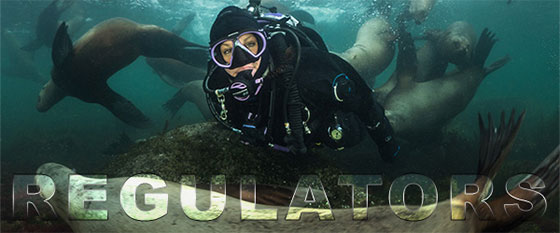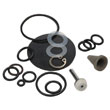Shop by Category
REGULATORS
Scuba diving regulators are what make diving possible. Forget every other piece of equipment; if you have a reg and an air source, you can dive. When Jacques Yves Cousteau and Emile Gagnan modified a welding regulator into a pressure-sensitive demand regulator in 1943, they opened the mysteries of the underwater world to anyone willing to discover them. In 1952, Melbourne based Ted Eldred invented the Porpoise separate first and second stage regulator that is the basis of today's modern regulator designs.
The Scuba Doctor has a wide range of regulators from carefully selected brands who all produce supreme performers in their own field of diving regulator design. These top-quality breathing regulators offer you enough choice to find the perfect regulator for your needs.
All of the scuba diving regulators we sell are CE EN250 certified. That is, they pass the requirements of the European standard for diving equipment to meet the demands placed on it at depth and under high breathing loads. This basically means that these regulators have been tested to make sure they will deliver gas to you at a depth of 50 metres, at acceptable temperatures, in any situation, even if you have two panicking divers demanding gas from them.
We're here to help you select the right scuba diving regulator, octopus and regulator accessories for your diving needs.
Types of Scuba Diving Regulators
Although there are many different brands and models of diving regulators to choose from there are only 3 basic types.
- Balanced
- Unbalanced
- Over Balanced
Each of these types has its own characteristics, benefits and drawbacks.
Regulator Features
Diving regulators have a host of features, all of which you need to consider before spending your hard-earned cash. From how your regs attach to your air tank, to what you should look for in a second stage, everything from top to bottom needs to be looked at closely.
Maintenance and Care
An important consideration most people overlook is maintenance. If you buy an older model second-hand regulator or some exotic piece of equipment, you may have a hard time getting it serviced.
Scuba regulators should be serviced annually and if your local shop can't do it, you may have just bought yourself an expensive paperweight.
You also have to think about what if you have a problem on vacation? Will you be able to get your diving regulator serviced on-site?
If you stick with a fairly new regulator, of common make and model, you shouldn't have any trouble with service, home or abroad.
Putting It All Together
Before you buy your first set of scuba regulators you have some thinking to do. Not about the nice shiny new toy you are going to buy, but about what kind of diving you do and what kind of diver you are.
If you dive mostly on vacation, in warm tropical waters, on shallow coral reefs, you will require a far less robust, and expensive, diving regulator than if you are plunging to the cold depths on mixed gas.
Be honest with yourself.
Make a checklist of what you are looking for in a scuba diving regulator.
Start reading reviews and manufacturers specifications. Or call or email us. We're here to help.
Do your homework and you'll have scuba regulators that you'll enjoy and be able to dive with for years.
Tech Tip: Hose Protectors Don't Protect Hoses
The 'hose protectors' on the ends of the hoses next to the first stage provide a cosmetic appearance, however, there is no evidence they prevent hose damage. Hoses sometimes fail where the fitting is swaged onto the hose, but that's caused by gas pressure, and a hose protector is not going to prevent that from happening. Because hose protectors interfere with routing and streamlining, they are almost never seen on regs used in technical diving. In fact, hose protectors may compromise safety and many experienced divers don't use or recommend them. Hose protectors hold water against the fitting, causing corrosion and hiding developing problems. The post-dive maintenance recommendation is to pull the hose protectors back from the fittings, rinse and inspect. However, our observation is that not only do most divers not perform this suggested maintenance, when they do they are actually pulling hard at the most failure-prone part of the hose. Our maintenance recommendation: permanently remove all hose protectors (we carefully use a pair of side cutters rather than pull them off) and replace the hose if there is evidence of excessive wear or damage.












